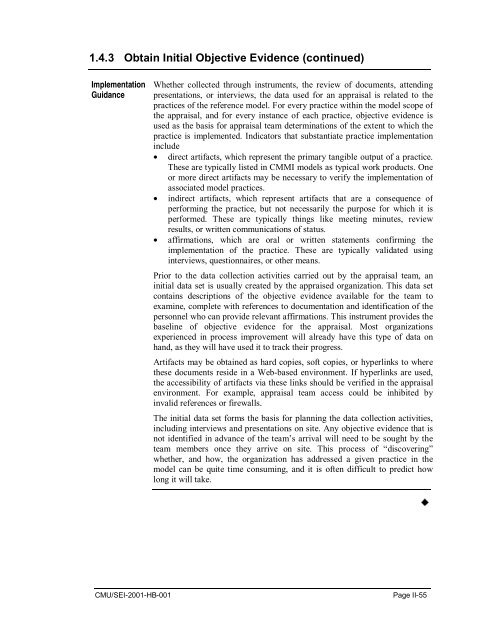Standard CMMI Appraisal Method for Process Improvement (SCAMPI)
Standard CMMI Appraisal Method for Process Improvement (SCAMPI)
Standard CMMI Appraisal Method for Process Improvement (SCAMPI)
You also want an ePaper? Increase the reach of your titles
YUMPU automatically turns print PDFs into web optimized ePapers that Google loves.
1.4.3 Obtain Initial Objective Evidence (continued)<br />
Implementation<br />
Guidance<br />
Whether collected through instruments, the review of documents, attending<br />
presentations, or interviews, the data used <strong>for</strong> an appraisal is related to the<br />
practices of the reference model. For every practice within the model scope of<br />
the appraisal, and <strong>for</strong> every instance of each practice, objective evidence is<br />
used as the basis <strong>for</strong> appraisal team determinations of the extent to which the<br />
practice is implemented. Indicators that substantiate practice implementation<br />
include<br />
• direct artifacts, which represent the primary tangible output of a practice.<br />
These are typically listed in <strong>CMMI</strong> models as typical work products. One<br />
or more direct artifacts may be necessary to verify the implementation of<br />
associated model practices.<br />
• indirect artifacts, which represent artifacts that are a consequence of<br />
per<strong>for</strong>ming the practice, but not necessarily the purpose <strong>for</strong> which it is<br />
per<strong>for</strong>med. These are typically things like meeting minutes, review<br />
results, or written communications of status.<br />
• affirmations, which are oral or written statements confirming the<br />
implementation of the practice. These are typically validated using<br />
interviews, questionnaires, or other means.<br />
Prior to the data collection activities carried out by the appraisal team, an<br />
initial data set is usually created by the appraised organization. This data set<br />
contains descriptions of the objective evidence available <strong>for</strong> the team to<br />
examine, complete with references to documentation and identification of the<br />
personnel who can provide relevant affirmations. This instrument provides the<br />
baseline of objective evidence <strong>for</strong> the appraisal. Most organizations<br />
experienced in process improvement will already have this type of data on<br />
hand, as they will have used it to track their progress.<br />
Artifacts may be obtained as hard copies, soft copies, or hyperlinks to where<br />
these documents reside in a Web-based environment. If hyperlinks are used,<br />
the accessibility of artifacts via these links should be verified in the appraisal<br />
environment. For example, appraisal team access could be inhibited by<br />
invalid references or firewalls.<br />
The initial data set <strong>for</strong>ms the basis <strong>for</strong> planning the data collection activities,<br />
including interviews and presentations on site. Any objective evidence that is<br />
not identified in advance of the team’s arrival will need to be sought by the<br />
team members once they arrive on site. This process of “discovering”<br />
whether, and how, the organization has addressed a given practice in the<br />
model can be quite time consuming, and it is often difficult to predict how<br />
long it will take.<br />
<br />
CMU/SEI-2001-HB-001<br />
Page II-55
















